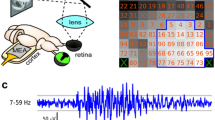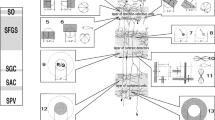Summary
Recent research has demonstrated that ipsilaterally visually evoked potentials (VEPs) can be measured within the ectostriatum, the telencephalic target area of the tectofugal visual pathway in birds. In this paper we systematically measured contra- and ipsilateral VEPs within the ectostriatal complex to obtain more detailed information on the processing of contra- and ipsilateral stimuli. The similarity of neighbouring VEPs at equal depth and a comparison of a one dimensional and a three dimensional analysis of current source-densities (CSDs) for identical coordinates suggested that a one dimensional current source-density analysis might be applicable. The one dimensional current source-density analysis demonstrated largely corresponding patterns in the sink — source sequences of the current source-density depth profiles for the contra- and ipsilateral stimulus responses. The occurrence of a large sink in the centre of the ectostriatal core, together with the results of multiunit recordings, shows that the ectostriatal core is the location of the generators for both the contra- and the ipsilaterally evoked responses. The occurrence of macroscopic sinks and sources and the fact that VEPs can be recorded from the ectostriatum shows that there is a higher degree of order in the ectostriatum than has been previously demonstrated by anatomical methods. The time coincidence between the maximum spike rate of multiunit responses, the negative peak of the evoked potential, and the large central sink demonstrates that the influence of ipsi- as well as of contralateral stimuli is predominantly excitatory.
Similar content being viewed by others
References
Benowitz LJ, Karten HJ (1976) Organisation of the tectofugal visual pathway in the pigeon: a retrograde transport study. J Comp Neurol 167: 503–520
Bischof HJ (1981) A stereotaxic headholder for small birds. Brain Res Bull 7: 435–436
Cohen DH, Karten HJ (1974) The structural organisation of the avian brain: an overview. In: Goodman IJ, Schein MW (eds) Birds, brain and behaviour. Academic Press, New York, pp 29–73
Ebbesson SOE (1970) On the organisation of central visual pathways in vertebrates. Brain Behav Evol 3: 178–194
Engelage J, Bischof HJ (1988) Enucleation enhances ipsilateral flash evoked responses in the ectostriatum of the zebra finch (Taeniopygia guttata castanotis Gould). Exp Brain Res 70: 79–89
Freemann JA, Nicholson C (1975) Experimental optimization of current source-density technique for anuran cerebellum. J Neurophysiol 38: 369–382
Freemann JA, Stone J (1969) A technique for current sourcedensity analysis of field potentials and its application to the frog cerebellum. In: Llinas R (ed) Neurobiology of cerebellar evolution and development. Am Med Assoc, Chicago, pp 421–430
Gamlin PDR, Cohen DH (1986) A second ascending pathway from the optic tectum to the telencephalon in the pigeon (Columba livia). J Comp Neurol 250: 296–310
Granda AM, Yazulla S (1971) The spectral sensitivity of single units in the nucleus rotundus of the pigeon, Columbia livia. J Gen Physiol 57: 363–384
Hardy O, Leresche N, Jassik-Gerschenfeld D (1984) Postsynaptic potentials in neurons of the pigeon's optic tectum in response to afferent stimulation from the retina and other visual structures: an intracellular study. Brain Res 311: 65–74
Holden AL (1968a) The field potential profile during activation of the avian optic tectum. J Physiol (Lond) 194: 75–90
Holden AL (1968b) Types of unitary response and correlation with the field potential profile during activation of the avian optic tectum. J Physiol (Lond) 194: 91–106
Hunt SP, Künzle H (1976) Observations of the projections and intrinsic organisation of the pigeon optic tectum: an autoradiographic study based on anterograde and retrograde axonal and dendritic flow. J Comp Neurol 170: 153–172
Jassik-Gerschenfeld D, Guichard J (1972) Visual receptive fields of single cells in the pigeon's optic tectum. Brain Res 40: 303–317
Kimberly RP, Holden AL, Bamborough P (1971) Response characteristics of pigeon forebrain cells to visual stimulation. Vision Res 11: 475–478
Llinas R, Nicholson C (1974) Analysis of field potentials in the central nervous system. In: Remond A (ed) Handbook of EEG and clinical neurophysiology, Vol 2. Electrical activity from the neuron to the EEG and EMG. Elsevier, Amsterdam, pp 62–92
Maxwell JH, Granda AM (1979) Receptive fields of movement sensitive cells in the pigeon thalamus. In: Maxwell JH, Granda AM (eds) Neural mechanisms of behavior in the pigeon. Plenum Press, New York, pp 177–198
Mitzdorf U (1985) Current source-density method and application in cat cerebral cortex: investigation of evoked potentials and EEG phenomena. Physiol Rev 65: 37–100
Mitzdorf U (1987) Properties of the evoked potential generators: current source-density analysis of visually evoked potentials in the cat cortex. Int J Neurosci 33: 33–59
Mitzdorf U, Singer W (1977) Laminar segregation of afferents to lateral geniculate nucleus of the cat: an analysis of current source-density. J Neurophysiol 40: 1227–1244
Mitzdorf U, Singer W (1978) Prominent excitatory pathways in the cat visual cortex (A17 and A18): a current source-density analysis of electrically evoked potentials. Exp Brain Res 33: 371–394
Mori S (1973) Analysis of field response in optic tectum of the pigeon. Brain Res 54: 193–206
Müller-Preuss P, Mitzdorf U (1984) Functional anatomy of the inferior colliculus and the auditory cortex: current source density analyses of click-evoked potentials. Hearing Res 16: 133–142
Nicholson C, Freeman JA (1975) Theory of current source-density analysis and determination of conductivity tensor for anuran cerebellum. J Neurophysiol 38: 356–368
Nixdorf BN, Bischof HJ (1982) Afferent connections of the ectostriatum and visual wulst in the zebra finch (Taeniopygia guttata castanotis Gould): a HRP study. Brain Res 248: 9–17
Parker DM, Delius JD (1972) Visual evoked potentials in the forebrain of the pigeon. Exp Brain Res 14: 198–209
Pettigrew JD (1977) Comparison of the retinotopic organization of the visual wulst in nocturnal and diurnal raptors, with a note on the evolution of frontal vision. In: Cool SJ, Smith III EL (eds) Frontiers in visual science. Springer, Berlin Heidelberg New York, pp 328–333
Revzin AM (1970) Some characteristics of wide field units in the brain of the pigeon. Brain Behav Evol 3: 195–204
Revzin AM, Karten HJ (1966/67) Rostral projections of the optic tectum and the nucleus rotundus in the pigeon. Brain Res 3: 264–276
Ritchie TC, Cohen DH (1977) The avian tectofugal visual pathway: projections of its telencephalic target, the ectostriatal complex. Soc Neurosci Abstr 3: 94
Robert F, Cuenod M (1969a) Electrophysiology of the intertectal commissures in the pigeon. I. Analysis of the pathways. Exp Brain Res 9: 116–121
Robert F, Cuenod M (1969b) Electrophysiology of the intertectal commissures in the pigeon. II. Inhibitory interaction. Exp Brain Res 9: 123–136
Stone J, Freemann JA (1971) Synaptic organization of the pigeon's optic tectum: a Golgi and current source-density analysis. Brain Res 27: 203–221
Yazulla S, Granda AM (1973) Opponent colour units in the thalamus of the pigeon (Columbia livia). Vision Res 13: 1555–1563
Watanabe M, Ito H, Ikushima M (1985) Cytoarchitecture and ultrastructure of the avian ectostriatum: afferent terminals from the dorsal telencephalon and some nuclei in the thalamus. J Comp Neurol 236: 241–257
Author information
Authors and Affiliations
Rights and permissions
About this article
Cite this article
Engelage, J., Bischof, H.J. Flash evoked potentials in the ectostriatum of the zebra finch: a current source-density analysis. Exp Brain Res 74, 563–572 (1989). https://doi.org/10.1007/BF00247358
Issue Date:
DOI: https://doi.org/10.1007/BF00247358




